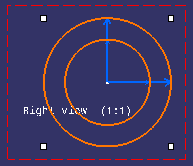This task shows you how to instantiate a 2D component previously created on a detail sheet.
Instantiating a 2D component means re-using it (from a layout detail sheet or from a component catalog) in a layout, once or several times. When you instantiate a 2D component, you create what is known as a "2D component instance", or an "instance".
Open the 2DComponent.CATPart document. Select Start > Mechanical Design > 2D Layout for 3D Design to open the layout in the 2D window, alongside the 3D window. Make sure Sheet.1 is active.
![]()
-
From the geometry area or from the specification tree, double-click the view in which you want to instantiate the 2D component (the right view, for example). This view is now active.
-
Click Instantiate 2D Component
 in the Layout toolbar.
in the Layout toolbar.

Double-clicking the Instantiate 2D Component icon lets you position several 2D components on
the sheet while keeping the scale and angle properties for all components. -
From the specification tree, click the 2D component under the detail sheet Sheet.2 (Detail) item.

A preview of the 2D component is displayed in the view. -
Position the component using smartpick then click.
The Tools Palette toolbar is displayed and proposes the following commands:
 Link with detail: instantiate a 2D component.
The component instance is linked with its reference in a detail sheet.
Link with detail: instantiate a 2D component.
The component instance is linked with its reference in a detail sheet.
 By default, this icon is activated.
By default, this icon is activated. Explode: instantiate and explode a 2D
component. The component instance is not linked to its reference, so behaves as independent geometry and annotations.
Explode: instantiate and explode a 2D
component. The component instance is not linked to its reference, so behaves as independent geometry and annotations. Fixed together:
instantiate and explode a 2D component, and apply a fixed together constraint to the geometry elements.
Fixed together:
instantiate and explode a 2D component, and apply a fixed together constraint to the geometry elements.

The fix together constraint is not applied to annotations, dimensions or dress-up elements.
 Change component origin: define another
point in the view.
Change component origin: define another
point in the view. Change component angle: define the angle in the view.
Change component angle: define the angle in the view. Flip component horizontally: rotate
horizontally the 2D component instance.
Flip component horizontally: rotate
horizontally the 2D component instance. Flip component vertically: rotate vertically
the 2D component instance.
Flip component vertically: rotate vertically
the 2D component instance.Angle: define a value for the angle.
Scale: define a value for the scale.
-
In the Tools Palette toolbar, choose your instance type. For the purpose of this scenario, check that the Link with detail
 icon is activated.
icon is activated.
-
Click the view: the 2D component instance is created.
If needed, select the component and use the displayed manipulators to modify the component.
Remember that if you selected Prevent direct manipulation and/or Prevent direct scaling from Tools > Options > Mechanical Design> Drafting > Annotation and Dress-up tab, you will not be able to move and/or scale the component.

![]()